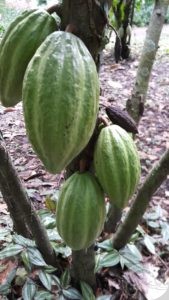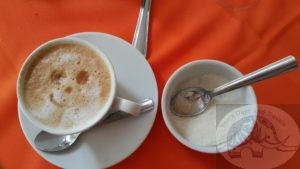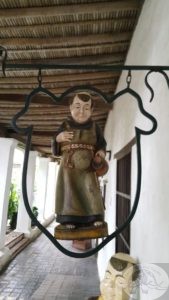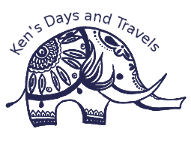
The pod of it all
$3.50 To Get Across the Country
Leaving Barquisimeto behind, I set out for San Felipe – one of the shorter bus trips in this journey. There I was to meet up with my friend with the debit card and the cash; not that I had much need of it yet, the first trip from San Cristobal to Barquisimeto had cost only about 3,500 Bolivars, or the equivalent of 3.50 dollars, for a distance of 544 kilometers (Greyhound, get yourself sorted). This leg cost even less, and I arrived in San Felipe with well over 20,000 Bolivars still in my day pack. We spent several hours just walking around, sorting out how much money could be withdrawn at any one time from the ATM machine, tasting some local food, and visiting a Mission/botanic garden.
A Strange pod…
As mentioned before, I love going to parks and gardens, there is a lot of peace and tranquility to be found in them, and nature is always beautiful. The Exotic Tropical Flora Park (Parque de la Exotica Flora Tropical y Mison Nuestra Senora del Carmen) is no different, and there was the added bonus of not having a large crowd of visitors ahead or behind us. This being a sub-tropical to tropical climate, the plants and flowers were not all that different from what I had seen in different parts of the world – the palms, the vines, the heliconias, the gingers, the orchids, but there was one particular type of tree which really attracted our attention. Neither one of us had seen such trees, nor such fruits, before. The trees were not very tall, rather skinny, but with plenty of fruit on them. The problem was, we could not for the life of us, find a fruit lying around on the ground. We searched, and searched, and must have covered nearly every square inch of the park where the trees grew before finally I heard a shout of joy, and my friend came out from behind a copse of trees carrying in his hands one of the weirdly shaped fruits. We didn’t dare crack it open, nor did we want to dispose of it, so we carried it with us as we toured the remainder of the park.

The glittering crystals in the small bowl… remained undisturbed.
Glittering crystals…
An hour or more after we started the tour, we finally came to the end of the trail, and arrived at a coffee shop. We entered the shop with the intention of setting our minds to figuring out where to go, since Angel Falls was out of the question, and Caracas was still a seething mass of protests. While waiting for the coffee to be served, we chatted about the conditions in Venezuela, the lines, the protests, the lack of basic commodities. We surmised about the strange tree and fruit, but couldn’t come up with an answer. As we were discussing the potential of going to a coastal town to spend a day or two on the beach, my latte was served, and I sat and stared for a few moments at the accompanying little jar. I fell silent and pointed, quietly, at the jar. My friend looked and I could see his eyes take on a sheer look of delight, for there, in front of us, stood a small jar of something I had not seen or tasted since leaving Cucuta four days earlier, and which he had not tasted for more than a month – the total value of the contents of the little jar would probably have amounted to a month’s salary for some people, and yet, there it stood. Shimmering, sparkling, like so many diamonds, the crystals reflecting the late afternoon sun. I did not dare touch it, much less put any of it in my coffee, and I saw the light dim in my friend’s eyes as he too turned away while I quietly replaced the lid on the jar. While so many were going without, neither one of us wanted the decadent experience of allowing our tongues to taste the sweetness released from those fine white crystals of sugar.

The Mission Nuestra Senora del Carmen
No Crystals, No Pod, No Souvenir
I moved the little jar out of sight, and we sighed for a moment before finishing our respective beverages. There was only one final thing to do before heading back into the city and dinner, to tour the Mission, and to find out what this mysterious fruit was that we had gathered earlier. As we approached the exit of the Mission, we noticed a small gift shop, and made our way inside. The attendant gave us a quick glance, then returned to reading her magazine. We looked at some of the gifts and souvenirs, but the bulkiness of most of them meant I could not possibly take any of them with me. Finished with our walk about, we approached the counter, and the attendant looked up. We asked her if she could identify the fruit that we had found. Watching people’s expressions is a wonderful pastime, and sometimes it can be quite rewarding, almost priceless, and on this occasions, I was not disappointed. From her earlier disinterested attitude, she suddenly shot up and gave us an OMG expression that could have been clearly seen in the peanut gallery of the largest concert hall in the world. “Where did you get this?” Was her query. We mentioned our long hunt for an exemplar that was not dangling from some tree, and she eyed us with great suspicion, but eventually seemed to think it better not to question the veracity of a gray-haired guest who obviously couldn’t speak Spanish. In a few words she explained that this was the fruit of the Cacao tree, and the beans contained within the fruit the source of what we know as chocolate. Native to South America, cacao beans were so valuable at one point during the Aztec Empire that they formed a major currency system. Although the price of cacao on the international market has dropped in recent years, it is still a valuable commodity; and as priceless as her expression had been when we showed her the cacao fruit, the expression she gave us when we asked if we could take the pod with us, left nothing to be interpreted. We thanked her, quietly, turned on our heels, and quickly departed, san cacao pod.
